How Soon After a Baby's First Tooth Can They Start Chewing Food
It takes a baby a few years to go from that adorable gummy smile to a mouth full of teeth. While the first tooth is a milestone and so cute to see, as a parent, you likely want to know when can you expect it to arrive and the others that follow.
Schedule A Dental Appointment
Use the links below to jump to sections in this blog post.
- When Do Babies Start Teething?
- Order of Eruption
- Which Baby Teeth Come First?
- Are My Baby's Teeth Late?
- When Do Babies Start Teething?
- When Can My Baby Eat Solid Food?
- Unique Situations and Potential Impacts on Tooth Development
-
- What If My Baby Is Born Early?
- What Happens When Teeth Come In Out Of Order?
- What Happens If I See Crowding In My Baby's Teeth?
- What Happens If I See a Blockage of My Baby's Teeth?
- What Happens If My Baby Has Impacted Teeth?
- What Happens If My Child Has Tooth Decay?
- How Can I Tell If Something Is Wrong With My Baby's Teeth?
- When to Contact Our Portland Pediatric Dentist?
When Do Babies Start Teething?
Baby teeth, also referred to as milk teeth, deciduous teeth or primary teeth, are temporary placeholders for your baby's permanent set of teeth to come in. They also play a significant role in your child's development.
Baby teeth eruption is a natural part of your baby's normal development, where your baby's teeth enter their mouth and become noticeable. By the time your baby turns three years old, they should have 20 teeth in their mouth. Even so, most of their baby (primary) teeth will appear during their first two years of life. To make room for their permanent teeth, your child will start losing their baby teeth around the age of six.
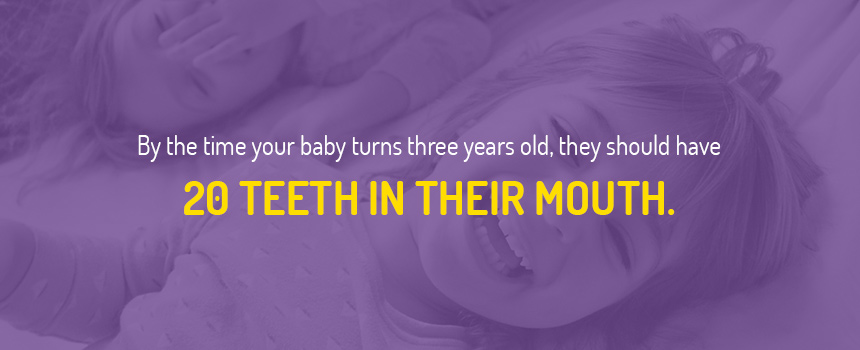
Usually, babies are born with tooth "buds" underneath their gums, embedded in the bone below. These baby tooth buds are areas where their 20 teeth will gradually erupt and develop. But there are some instances where the process of tooth eruption doesn't follow the text-book pattern of normal eruption. There is a possibility your baby's teeth won't erupt in the expected order, or perhaps there's a substantial delay.
Each baby is different in the teeth development process, though, so don't be alarmed if your child's tooth eruption follows a slightly different pattern. Some may begin teething as early as four to seven months. Others may be around nine months before they get their first teeth, or even not until they're a year old. In some cases, a baby might even be born with a couple of teeth already! Genetics can play a huge role. If you or your partner developed your primary teeth early, there's a good chance your child will, too.
Once you understand what to look for, you can contact our Fox Kids Dentistry & Orthodontics pediatric dentist if you have any concerns.
Why Choose A Pediatric Dentist
Order of Eruption and What Each Set of Teeth Is Designed to Help Babies Do
Below is the typical baby teeth order of appearance, when you can expect to see the primary teeth come in, and what their job is:
Central Incisor
Function: The central incisors are thin and flat. Their function is to slice through the food you eat, and they support the appearance and shape of your lips. They also help you pronounce certain sounds such as "th" and "t." They help guide the jaw into its proper position when you close your mouth as well. You have both upper and lower central incisors.
Upper
When the tooth comes in: eight to 12 months old
When the tooth falls out: six to seven years old
Lower
When the tooth comes in: six to 10 months old
When the tooth falls out: six to seven years old
Lateral Incisor

Function: These are the two teeth that sit next to the left and right sides of your central incisors. They're also referred to as being away from the center of your jaw or being in the distal position. The primary function of the incisors is cutting and tearing into food, although the aesthetic appearance of these teeth are scrutinized immensely since they're visible while eating, smiling and talking. You have both upper and lower lateral incisors, too.
Upper
When the tooth comes in: nine to 13 months old
When the tooth falls out: seven to eight years old
Lower
When the tooth comes in: 10 to 16 months old
When the tooth falls out: seven to eight years old
Canine (Cuspid)
Function: The canines are located at the "corners" of your dental arches. They have a pointed, sharp biting surface, so they can perform their function of gripping and tearing food.
Upper
When the tooth comes in: 16 to 22 months old
When the tooth falls out: 10 to 12 years old
Lower
When the tooth comes in: 17 to 23 months old
When the tooth falls out: nine to 12 years old
Molars
Function: Your molars are your largest teeth in your mouth. Their biting surfaces are flat, and their function is to crush, chew and grind food. You have eight molars.
First Molar
Upper
When the tooth comes in: 13 to 19 months old
When the tooth falls out: nine to 11 years old
Lower
When the tooth comes in: 14 to 18 months old
When the tooth falls out: nine to 11 years old
Second Molar
Upper
When the tooth comes in: 25 to 33 months old
When the tooth falls out: 10 to 12 years old
Lower
When the tooth comes in: 23 to 31 months old
When the tooth falls out: 10 to 12 years old
Your child's permanent teeth should start coming around the age of six years old.
In some kids, the first to emerge are the first permanent molars, and in others, it's the incisors. Most of the 28 permanent teeth should be in and in place by the age of 13. By the age of 17 and 21 years old, one to four third molars, or wisdom teeth may emerge, bringing the total permanent teeth number to 32.
Based on this information, here are some answers to other common questions parents will ask us about their child's teeth:
1. Which Baby Teeth Come First?
Typically, the first baby teeth start breaking through the gums around the age of six months old. The two bottom central incisors are usually the first two teeth to come in.
2. Are My Baby's Teeth Late?
New parents eagerly wait for their baby's first tiny white buds to start showing, which is a signal their first baby teeth are about to come in. Therefore, when they don't show up, parents begin to worry something is wrong. For most babies with no teeth, this delay isn't usually something to be concerned about. However, there could be an underlying cause too in some babies.
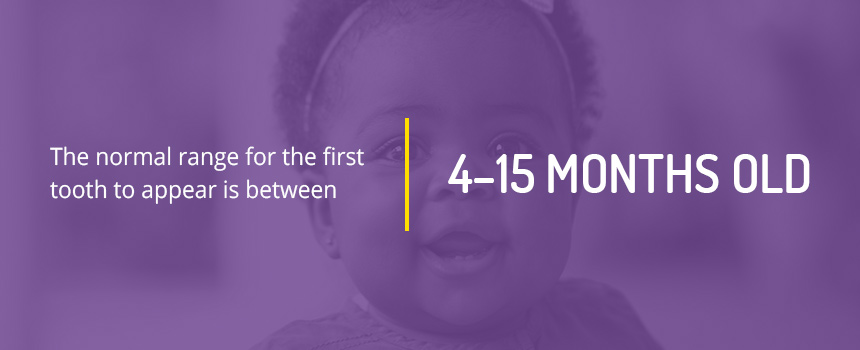
So, according to the American Academy of Pediatrics (AAP), if your child hasn't popped their first tooth by the time they reach 18 months old, you should take them to the pediatric dentist. The normal range for the first tooth to appear is between four to 15 months old. Afterward, the other teeth begin erupting in a regular pattern.
3. When Do Babies Start Teething?
Most babies have their first tooth or teeth erupt by the time they're four to six months old. However, some children's teeth show up earlier or later.
4. When Can My Baby Eat Solid Food?
Most babies are ready to start eating solid foods along with their formula-feeding or breastfeeding by the ages of four to six months old.
Unique Situations and Potential Impacts on Children's Tooth Development
By the time your child turns three years old, they should have a complete set of 20 baby teeth, giving them a brilliant grin. Going from toothless to a full grin takes time. And, many parents have a lot of questions when it comes to their child's baby teeth.
However, there are some unique situations that can affect the exact timing of when your baby's teeth begin to erupt as well as when and how the permanent teeth come in. Here's a look at some of those situations:
1. What If My Baby Is Born Early?
On average, a baby usually gets their first tooth at around six months, but all babies are different. Children that are born prematurely should be calculated at the corrected age. For instance, if your child was born a month premature, their teeth may begin erupting at seven months instead of six.
Teething issues occur the most in premature babies, along with those that don't have sufficient healthcare access. You should contact one of our pediatric dentists if you notice your baby hasn't had any tooth eruptions by the time they're 18 months old. However, it's recommended that babies start seeing a pediatric dentist by their first birthday.
While there should not be too many significant problems with a later order of appearance, you should consult our pediatric dentist if your baby hasn't had any teeth erupt by their first birthday. You shouldn't be too concerned unless you have a family history of teeth missing or your child has another underlying health condition.
2. What Happens When Teeth Come in out of Order?
Because all babies have different timetables, don't be too concerned if your baby's teeth erupt at a different time than most babies. Some teeth can take a little longer to erupt, while other times, the teeth will erupt earlier than normal ― even as early as four months old.
Your baby's teeth may also erupt in a different pattern than what's considered the normal pattern. For instance, your child's front upper teeth may erupt first. When this occurs, there's no need to worry. It doesn't matter the exact order the teeth come in as long as your child has a gleaming set of 20 teeth by about their third birthday.
Now, there can be potential complications when teeth erupt out of order. All potential complications should be addressed right away to avoid long-term effects. For instance, if permanent teeth come in at an abnormal position, it can affect the spacing of all the permanent teeth.
3. What Happens If I See Crowding in My Baby's Teeth?
Crowding is when there's a lack of space for the teeth to normally fit into the jaw. The teeth might be displaced or rotated. Crowding can be due to late or early loss of baby teeth, a genetic imbalance between tooth size and jaw, or improper tooth eruption. Crowded baby teeth will often result in crowded permanent teeth, so spacing or crowding of your child's teeth may be a good predictor as to what things will look like as they grow older.
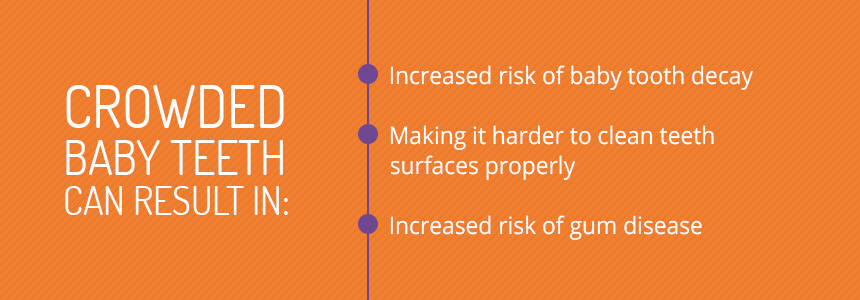
You should have crowding corrected since it can:
- Increase the risk of baby tooth decay
- Make it harder to clean the teeth surfaces properly
- Increase the risk of gum disease
4. What Happens If I See a Blockage of My Baby's Teeth?
Sometimes, if baby teeth erupt out of order, it can later block some permanent teeth from coming in because the baby teeth haven't fallen out yet. Often the permanent tooth will come in anyway. This poses a higher risk of cavities developing since the teeth are then harder to clean. It's also possible for the surrounding baby teeth to come out prematurely in this circumstance, which can affect the growth and development of the jaw and other facial bones.
5. What Happens If My Baby Has Impacted Teeth?
Impacted baby teeth are very rare. Impactions are more likely to occur with permanent teeth. When there's a lack of space, some of the permanent teeth might not come through because they're totally blocked. When there's an occurrence of impacted teeth, damage can occur to surrounding bone and gum tissues as well as to the teeth's roots.
If you have any concerns about any complications, consult with your child's pediatric dentist.
6. What Happens If My Child Has Tooth Decay?
Another problem is tooth decay, and primary teeth are, unfortunately, at a higher risk for it. When there's decay, it can lead to other complications like below and warrant an examination and potential treatment by our pediatric dentist:
- Early tooth loss: When there's early baby tooth loss, whether it's one tooth or a couple, it can leave space that isn't ready to be filled yet. It's essential to consult with a pediatric dentist to see if treatment is needed to prevent future orthodontic challenges later on in your child's life.
- Infections: Infected teeth due to tooth decay can cause poor eating habits, crooked teeth, speech problems and damaged adult teeth.
- Cellulitis: This is inflammation that spread to the mouth's surrounding soft tissues. It's a dental emergency because if left untreated, can lead to significant infection. Your child will likely experience redness, pain and substantial swelling. Our dentist will need to prescribe antibiotics and if this condition affects your child's teeth, and extraction may be needed.
- Gingivitis (gum disease): Gum disease typically causes the gum tissue to turn red, swell and bleed easily. Gum disease is both treatable and preventable with regular good oral hygiene and professional dental care.
- Yellow or brown spots on teeth: White spots seen on baby teeth are actually early tooth decay signs. They are caused by enamel mineral loss. If they are left untreated, they can turn brown or yellow and require more extensive dental treatment.
- Cavities: Tooth decay in toddlers can cause early childhood caries.
- Poor self-esteem: Having a mouth full of cavities or misaligned teeth can lead to poor self-esteem. This is also why you shouldn't hesitate to bring your child to the dentist.
Learn More About Dental Exams
How Can I Tell If Something Is Wrong With My Baby's Teeth?
While variations are completely normal, preventing early space loss and disease is important. Because the primary teeth are smaller than adult teeth (permanent teeth), they should leave plenty of space between them, allowing for room for future teeth. If you're worried about your child's teeth growing in too close together, have a pediatric dentist take a look.
When to Contact Our Portland Pediatric Dentistry
You should schedule your child's first dental appointment once their first tooth erupts and subsequently if other problems show up. A pediatric dentist is best since they have additional years of training, making them experts on baby teeth, and they have a lots of experience dealing with pediatric dental problems.
Again, there's no need to panic if your baby's teeth grow in out of order. There may be several reasons for the delay, but generally, most, if not all, baby teeth will be in place in due time. Unless you notice complications, please be patient.
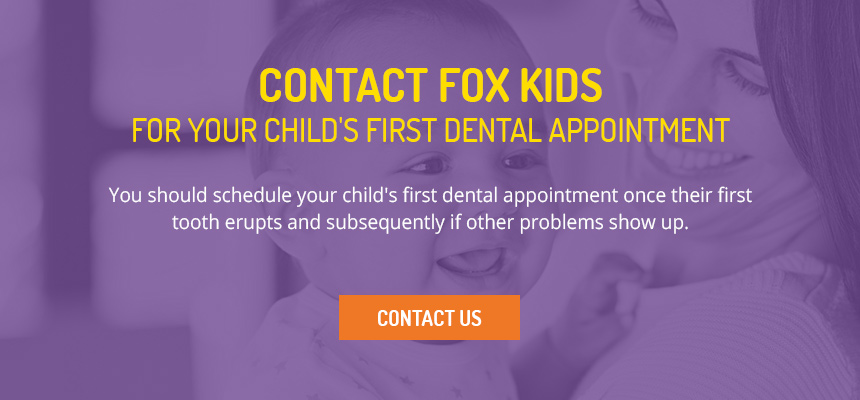
Also, even though your baby's milk teeth will be replaced by permanent teeth eventually, this doesn't mean you should ignore your child's good dental hygiene with their baby teeth. Healthy development and proper oral hygiene will set your baby up for proper, oral health in the future. Contact Fox Kids in Portland today at 503-223-5039 to set up your baby's first appointment or to address any concerns you have. We can't wait to meet you and your little one!
Summary
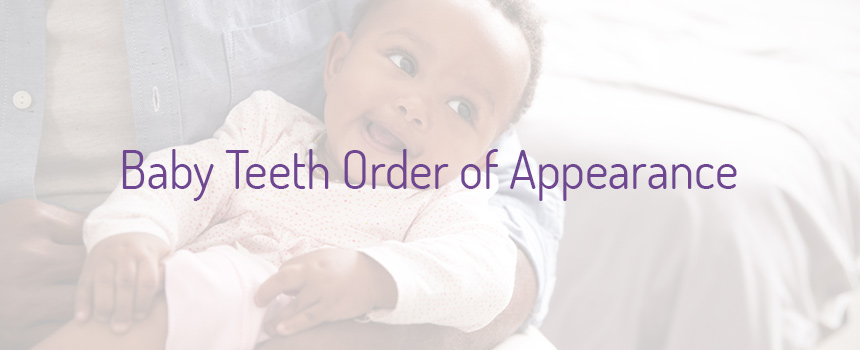
Article Name
Baby Teeth - Order of Appearance
Description
It takes a baby a few years to go from that adorable gummy smile to a mouth full of teeth. While the first tooth is a milestone and so cute to see, as a parent, you likely want to know when you can expect it to arrive, and the others that follow.
Author
Dr. Dana Fox
Publisher Name
Fox Kids Pediatric Dentistry & Orthodontics
Publisher Logo

Disclaimer
This blog provides general information and discussion about dentistry and other health related topics. The opinions and content expressed on this blog are for general conversational purposes only and should not be interpreted as dental or medical advice pertaining to any particular individual. If the reader or any other person has a dental or medical concern, he or she should consult with an appropriately-licensed dentist, physician or other health care provider.
How Soon After a Baby's First Tooth Can They Start Chewing Food
Source: https://foxkidsdentistry.com/blog/baby-teeth-order-of-appearance/
0 Response to "How Soon After a Baby's First Tooth Can They Start Chewing Food"
Post a Comment